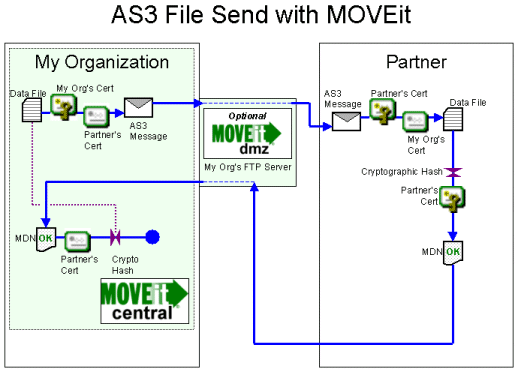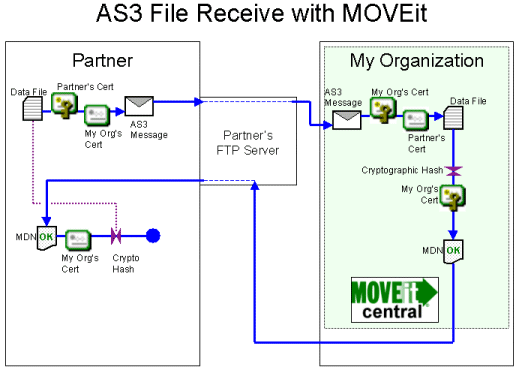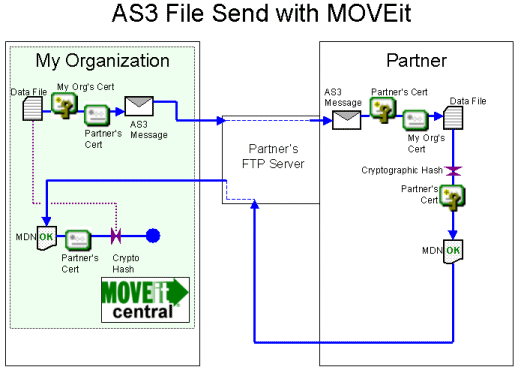
The AS3 protocol is based on FTP. It is the latest ASx protocol developed and uses the same signing, encryption and MDN conventions used in the original AS1 protocol. After AS1, AS3 is probably the easiest ASx protocol to set up and work with (if firewall issues do not crop up), but AS3 still trails AS2 in terms of general acceptance.
Like any other ASx file transfer, AS3 file transfers typically require both sides of the exchange to trade SSL certificates and specific "trading partner" names before any transfers can take place. AS3 trading partner names can be any valid phrase.

Variations
FTP Server Location - The FTP server used in an AS3 transfer could be your FTP server, your partner's FTP server or a hosted FTP server somewhere else. If you have control over the FTP server, we recommend deploying/using a MOVEit DMZ FTP server.
MOVEit Central is the only MOVEit product required to send or receive files using AS1. In either case files and MDNs are sent through FTP servers, and we recommend deploying/using a MOVEit DMZ FTP server when possible.
...Using Your FTP Server


...Using Your Partner's FTP Server (Or a Hosted FTP Server)


See also:
AS3 was developed to add ASx file transfer capabilities to the well-established FTP/SSL ("FTPS") protocol. Also, using FTP as a transport rather than HTTP seemed to address the "no standard regarding username/password" limitation of AS2: most FTP servers already require username/password. The AS3 protocol is generally recognized by various industries as the "next" ASx protocol, but movement toward AS3 from established AS2 users has not been rapid.
Advantage: If you have an AS3 client and access to an FTP server, you can send and receive AS3 transmissions. You do not need to control or host the FTP server participating in an AS3 transmission, so AS3 ranks just behind AS1 in terms of easiest ASx protocols to install and configure as long as firewall issues are not much of a concern.
Disadvantage: AS3 has frequent firewall issues. AS3 is built on the FTP/SSL protocol, one of the most firewall-unfriendly protocols in use today. Some of the common issues involving FTP/SSL involve NAT translation, multiple data ports and improper translation of FTP commands by intervening firewalls. (Some people look for SSH and/or HTTP file transfer solutions specifically to avoid reoccurring FTP/SSL firewall issues; MOVEit products offer several tactical solutions for various FTP/SSL issues in terms of features and support.)
Disadvantage: No AS3 transmission mode is as fast as AS2 "synchronous MDN" transfers. This is likely the issue that keeps established many ASx players from moving from AS2 to AS3. When AS2 senders request on-the-fly "synchronous MDNs" for their small file transfers (such as part orders), AS2 is by far the fastest ASx protocol. The AS3 protocol does not support similar MDN-on-the-fly capabilities.
See also: Comparison of AS1, AS2 and AS3 on the "AS1, AS2 and AS3 - Overview" page.